Cloud Storage Implementation: Hybrid Approach and XYZ Company
VerifiedAdded on 2023/04/06
|10
|1989
|191
Report
AI Summary
This report discusses the implementation of cloud storage within the XYZ organization, focusing on the adoption of a hybrid cloud approach. It explores the experiences of the organization with various cloud vendors like Amazon AWS and Google Cloud, highlighting the advantages of hybrid cloud solutions, such as customizable data storage and enhanced security, alongside the disadvantages, including the need for technical expertise and potential data inaccessibility due to server downtime. The report also addresses the importance of selecting the right cloud vendor and service type, the challenges faced by XYZ Company, such as slow data restoration, and the increased internet utilization post-implementation. Ultimately, the report concludes that successful cloud deployment hinges on careful vendor selection and service type, despite potential challenges.
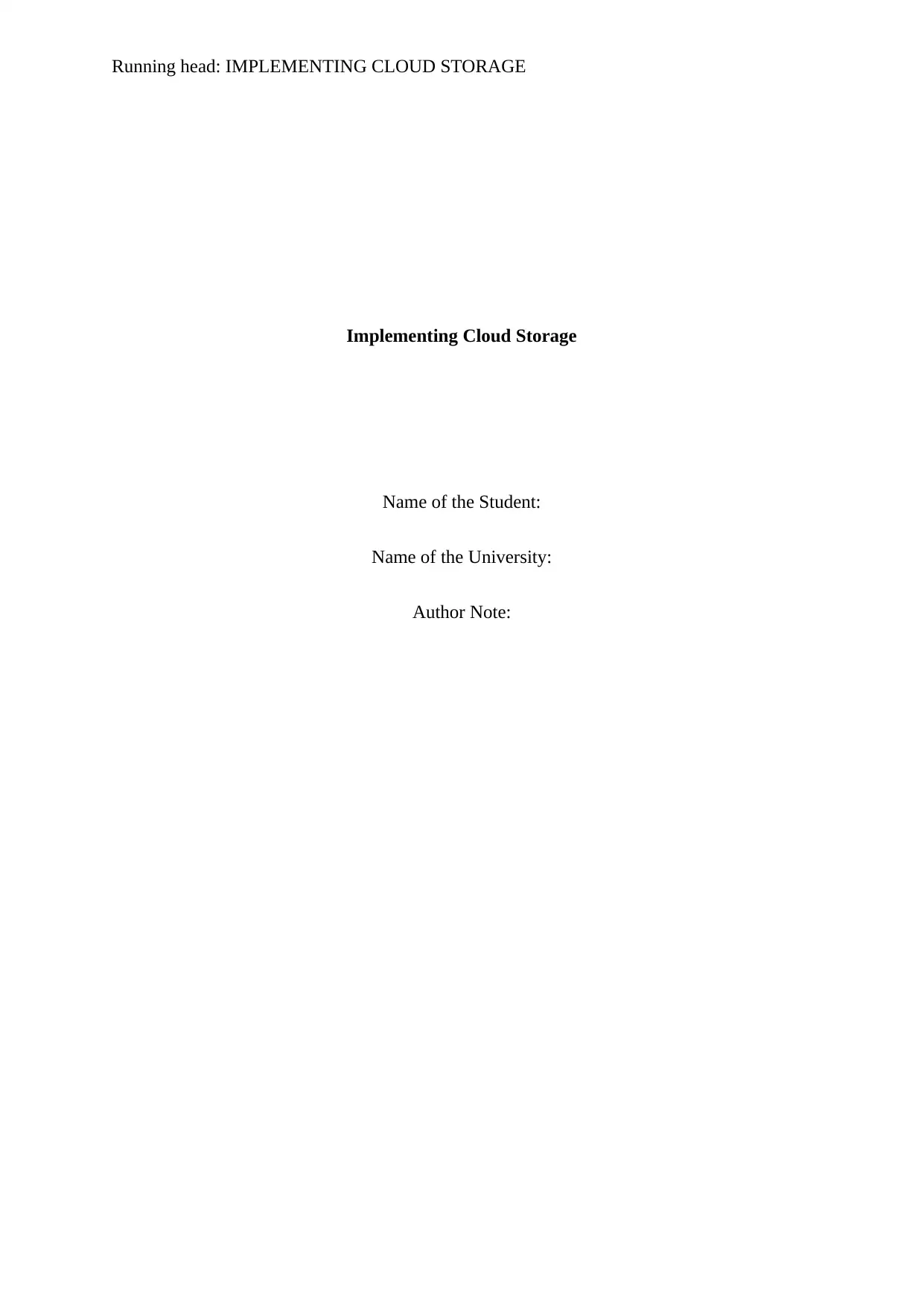
Running head: IMPLEMENTING CLOUD STORAGE
Implementing Cloud Storage
Name of the Student:
Name of the University:
Author Note:
Implementing Cloud Storage
Name of the Student:
Name of the University:
Author Note:
Paraphrase This Document
Need a fresh take? Get an instant paraphrase of this document with our AI Paraphraser

1
IMPLEMENTING CLOUD STORAGE
Table of Contents
1. Introduction............................................................................................................................3
2. Discussion..............................................................................................................................3
2. 1 Experience with cloud based storage companies:...........................................................3
2.2 Advantages of using hybrid cloud....................................................................................5
2.3 Disadvantages of cloud computing..................................................................................6
3. Conclusion..............................................................................................................................7
References..................................................................................................................................8
IMPLEMENTING CLOUD STORAGE
Table of Contents
1. Introduction............................................................................................................................3
2. Discussion..............................................................................................................................3
2. 1 Experience with cloud based storage companies:...........................................................3
2.2 Advantages of using hybrid cloud....................................................................................5
2.3 Disadvantages of cloud computing..................................................................................6
3. Conclusion..............................................................................................................................7
References..................................................................................................................................8
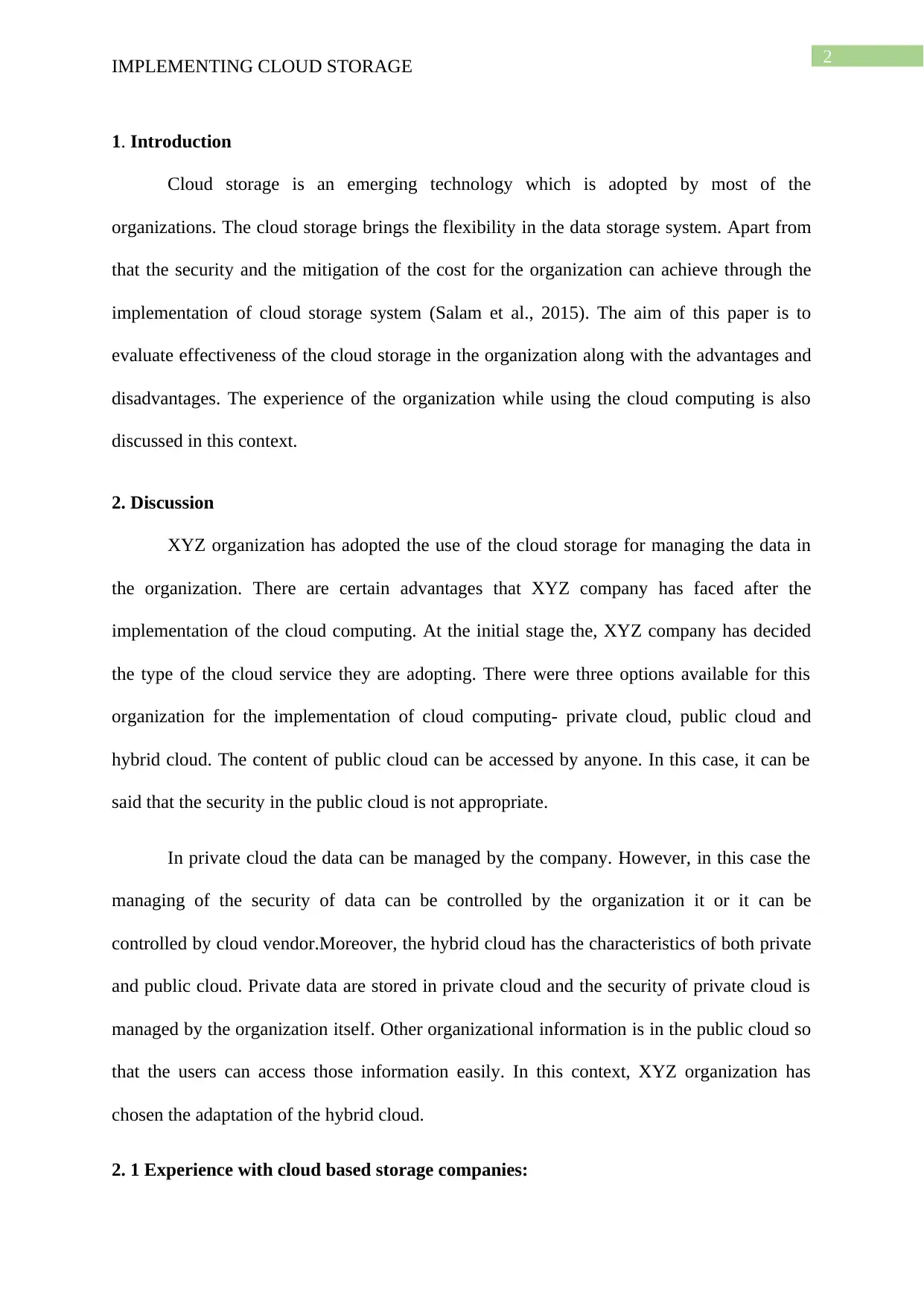
2
IMPLEMENTING CLOUD STORAGE
1. Introduction
Cloud storage is an emerging technology which is adopted by most of the
organizations. The cloud storage brings the flexibility in the data storage system. Apart from
that the security and the mitigation of the cost for the organization can achieve through the
implementation of cloud storage system (Salam et al., 2015). The aim of this paper is to
evaluate effectiveness of the cloud storage in the organization along with the advantages and
disadvantages. The experience of the organization while using the cloud computing is also
discussed in this context.
2. Discussion
XYZ organization has adopted the use of the cloud storage for managing the data in
the organization. There are certain advantages that XYZ company has faced after the
implementation of the cloud computing. At the initial stage the, XYZ company has decided
the type of the cloud service they are adopting. There were three options available for this
organization for the implementation of cloud computing- private cloud, public cloud and
hybrid cloud. The content of public cloud can be accessed by anyone. In this case, it can be
said that the security in the public cloud is not appropriate.
In private cloud the data can be managed by the company. However, in this case the
managing of the security of data can be controlled by the organization it or it can be
controlled by cloud vendor.Moreover, the hybrid cloud has the characteristics of both private
and public cloud. Private data are stored in private cloud and the security of private cloud is
managed by the organization itself. Other organizational information is in the public cloud so
that the users can access those information easily. In this context, XYZ organization has
chosen the adaptation of the hybrid cloud.
2. 1 Experience with cloud based storage companies:
IMPLEMENTING CLOUD STORAGE
1. Introduction
Cloud storage is an emerging technology which is adopted by most of the
organizations. The cloud storage brings the flexibility in the data storage system. Apart from
that the security and the mitigation of the cost for the organization can achieve through the
implementation of cloud storage system (Salam et al., 2015). The aim of this paper is to
evaluate effectiveness of the cloud storage in the organization along with the advantages and
disadvantages. The experience of the organization while using the cloud computing is also
discussed in this context.
2. Discussion
XYZ organization has adopted the use of the cloud storage for managing the data in
the organization. There are certain advantages that XYZ company has faced after the
implementation of the cloud computing. At the initial stage the, XYZ company has decided
the type of the cloud service they are adopting. There were three options available for this
organization for the implementation of cloud computing- private cloud, public cloud and
hybrid cloud. The content of public cloud can be accessed by anyone. In this case, it can be
said that the security in the public cloud is not appropriate.
In private cloud the data can be managed by the company. However, in this case the
managing of the security of data can be controlled by the organization it or it can be
controlled by cloud vendor.Moreover, the hybrid cloud has the characteristics of both private
and public cloud. Private data are stored in private cloud and the security of private cloud is
managed by the organization itself. Other organizational information is in the public cloud so
that the users can access those information easily. In this context, XYZ organization has
chosen the adaptation of the hybrid cloud.
2. 1 Experience with cloud based storage companies:
⊘ This is a preview!⊘
Do you want full access?
Subscribe today to unlock all pages.

Trusted by 1+ million students worldwide
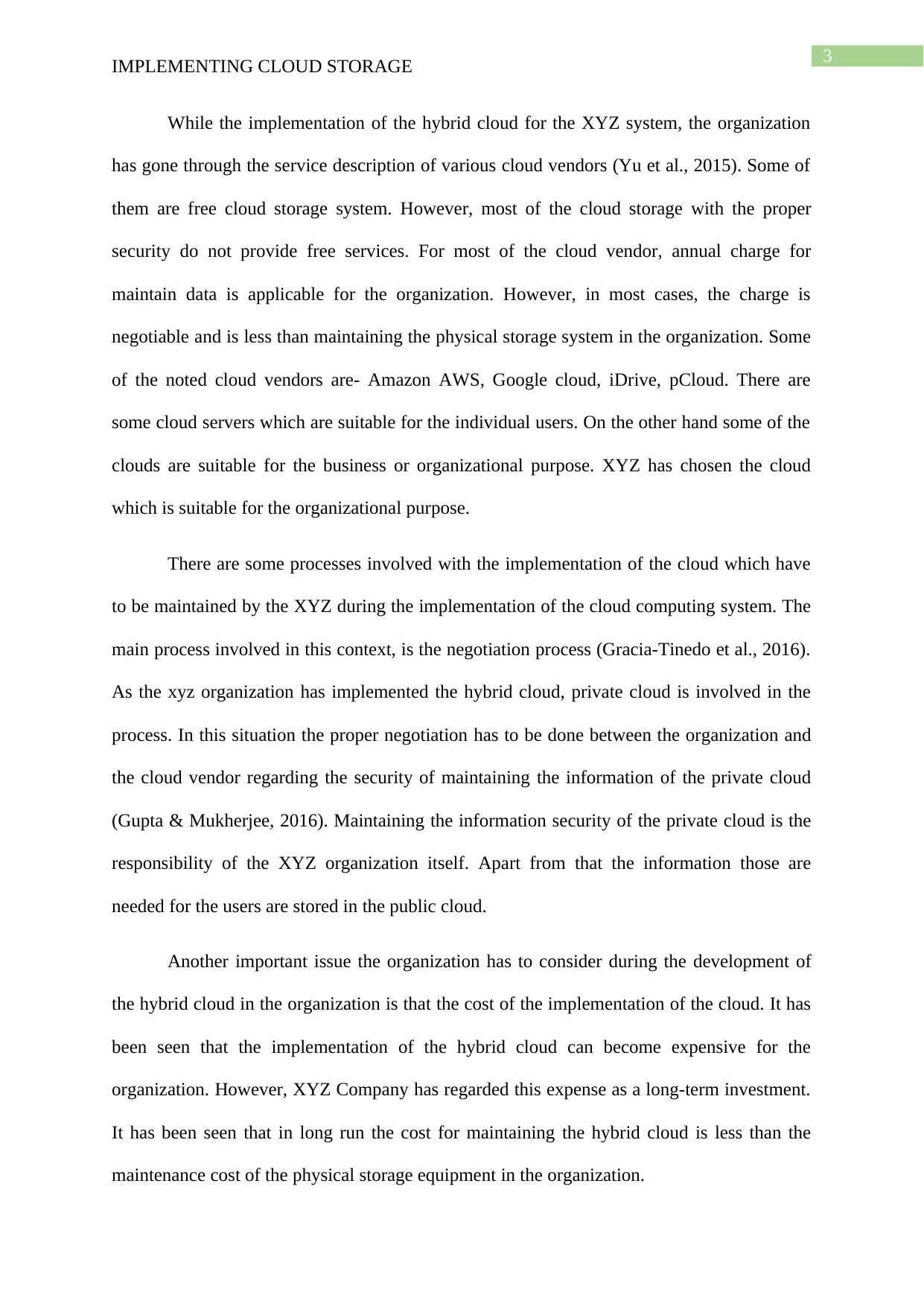
3
IMPLEMENTING CLOUD STORAGE
While the implementation of the hybrid cloud for the XYZ system, the organization
has gone through the service description of various cloud vendors (Yu et al., 2015). Some of
them are free cloud storage system. However, most of the cloud storage with the proper
security do not provide free services. For most of the cloud vendor, annual charge for
maintain data is applicable for the organization. However, in most cases, the charge is
negotiable and is less than maintaining the physical storage system in the organization. Some
of the noted cloud vendors are- Amazon AWS, Google cloud, iDrive, pCloud. There are
some cloud servers which are suitable for the individual users. On the other hand some of the
clouds are suitable for the business or organizational purpose. XYZ has chosen the cloud
which is suitable for the organizational purpose.
There are some processes involved with the implementation of the cloud which have
to be maintained by the XYZ during the implementation of the cloud computing system. The
main process involved in this context, is the negotiation process (Gracia-Tinedo et al., 2016).
As the xyz organization has implemented the hybrid cloud, private cloud is involved in the
process. In this situation the proper negotiation has to be done between the organization and
the cloud vendor regarding the security of maintaining the information of the private cloud
(Gupta & Mukherjee, 2016). Maintaining the information security of the private cloud is the
responsibility of the XYZ organization itself. Apart from that the information those are
needed for the users are stored in the public cloud.
Another important issue the organization has to consider during the development of
the hybrid cloud in the organization is that the cost of the implementation of the cloud. It has
been seen that the implementation of the hybrid cloud can become expensive for the
organization. However, XYZ Company has regarded this expense as a long-term investment.
It has been seen that in long run the cost for maintaining the hybrid cloud is less than the
maintenance cost of the physical storage equipment in the organization.
IMPLEMENTING CLOUD STORAGE
While the implementation of the hybrid cloud for the XYZ system, the organization
has gone through the service description of various cloud vendors (Yu et al., 2015). Some of
them are free cloud storage system. However, most of the cloud storage with the proper
security do not provide free services. For most of the cloud vendor, annual charge for
maintain data is applicable for the organization. However, in most cases, the charge is
negotiable and is less than maintaining the physical storage system in the organization. Some
of the noted cloud vendors are- Amazon AWS, Google cloud, iDrive, pCloud. There are
some cloud servers which are suitable for the individual users. On the other hand some of the
clouds are suitable for the business or organizational purpose. XYZ has chosen the cloud
which is suitable for the organizational purpose.
There are some processes involved with the implementation of the cloud which have
to be maintained by the XYZ during the implementation of the cloud computing system. The
main process involved in this context, is the negotiation process (Gracia-Tinedo et al., 2016).
As the xyz organization has implemented the hybrid cloud, private cloud is involved in the
process. In this situation the proper negotiation has to be done between the organization and
the cloud vendor regarding the security of maintaining the information of the private cloud
(Gupta & Mukherjee, 2016). Maintaining the information security of the private cloud is the
responsibility of the XYZ organization itself. Apart from that the information those are
needed for the users are stored in the public cloud.
Another important issue the organization has to consider during the development of
the hybrid cloud in the organization is that the cost of the implementation of the cloud. It has
been seen that the implementation of the hybrid cloud can become expensive for the
organization. However, XYZ Company has regarded this expense as a long-term investment.
It has been seen that in long run the cost for maintaining the hybrid cloud is less than the
maintenance cost of the physical storage equipment in the organization.
Paraphrase This Document
Need a fresh take? Get an instant paraphrase of this document with our AI Paraphraser
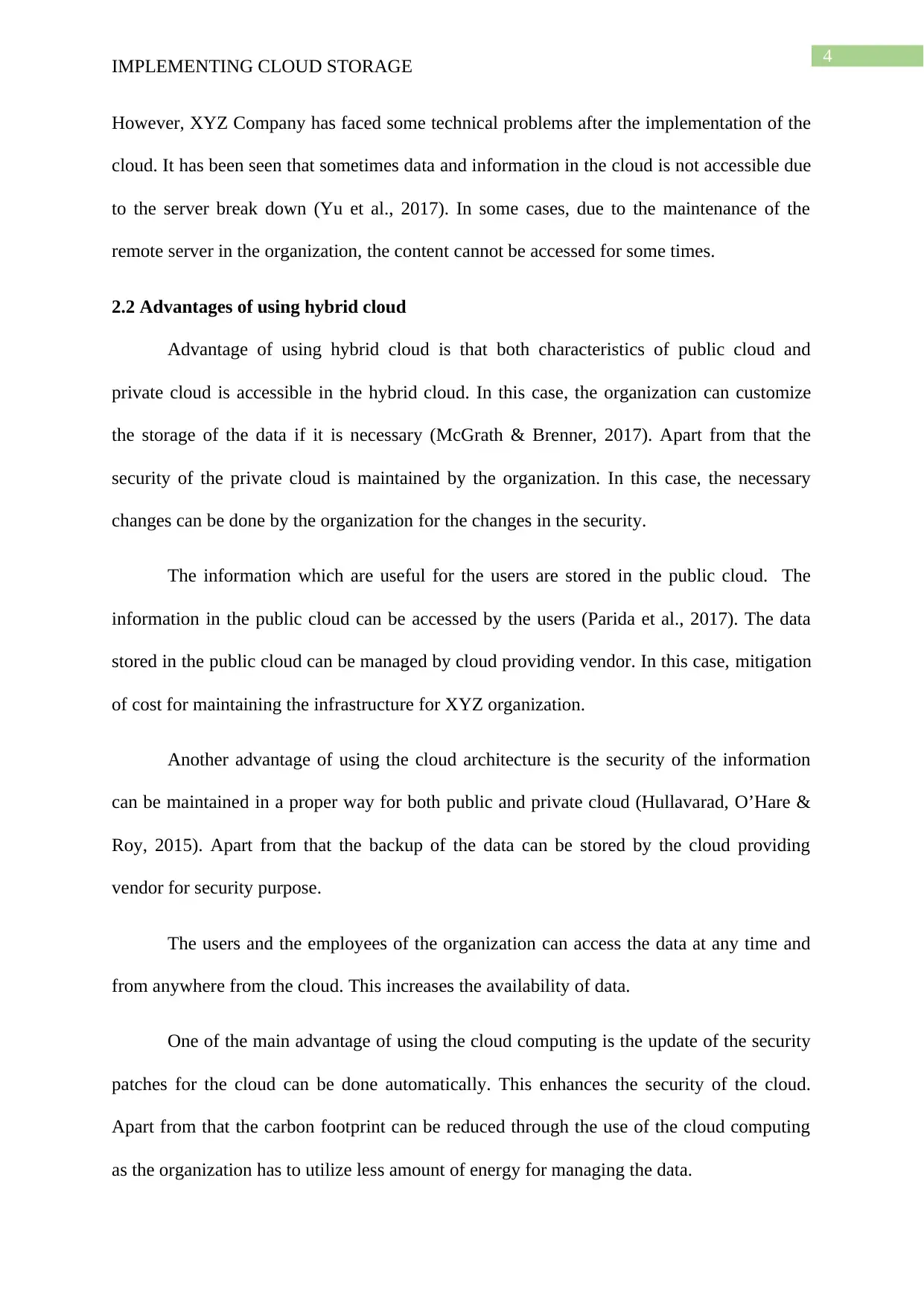
4
IMPLEMENTING CLOUD STORAGE
However, XYZ Company has faced some technical problems after the implementation of the
cloud. It has been seen that sometimes data and information in the cloud is not accessible due
to the server break down (Yu et al., 2017). In some cases, due to the maintenance of the
remote server in the organization, the content cannot be accessed for some times.
2.2 Advantages of using hybrid cloud
Advantage of using hybrid cloud is that both characteristics of public cloud and
private cloud is accessible in the hybrid cloud. In this case, the organization can customize
the storage of the data if it is necessary (McGrath & Brenner, 2017). Apart from that the
security of the private cloud is maintained by the organization. In this case, the necessary
changes can be done by the organization for the changes in the security.
The information which are useful for the users are stored in the public cloud. The
information in the public cloud can be accessed by the users (Parida et al., 2017). The data
stored in the public cloud can be managed by cloud providing vendor. In this case, mitigation
of cost for maintaining the infrastructure for XYZ organization.
Another advantage of using the cloud architecture is the security of the information
can be maintained in a proper way for both public and private cloud (Hullavarad, O’Hare &
Roy, 2015). Apart from that the backup of the data can be stored by the cloud providing
vendor for security purpose.
The users and the employees of the organization can access the data at any time and
from anywhere from the cloud. This increases the availability of data.
One of the main advantage of using the cloud computing is the update of the security
patches for the cloud can be done automatically. This enhances the security of the cloud.
Apart from that the carbon footprint can be reduced through the use of the cloud computing
as the organization has to utilize less amount of energy for managing the data.
IMPLEMENTING CLOUD STORAGE
However, XYZ Company has faced some technical problems after the implementation of the
cloud. It has been seen that sometimes data and information in the cloud is not accessible due
to the server break down (Yu et al., 2017). In some cases, due to the maintenance of the
remote server in the organization, the content cannot be accessed for some times.
2.2 Advantages of using hybrid cloud
Advantage of using hybrid cloud is that both characteristics of public cloud and
private cloud is accessible in the hybrid cloud. In this case, the organization can customize
the storage of the data if it is necessary (McGrath & Brenner, 2017). Apart from that the
security of the private cloud is maintained by the organization. In this case, the necessary
changes can be done by the organization for the changes in the security.
The information which are useful for the users are stored in the public cloud. The
information in the public cloud can be accessed by the users (Parida et al., 2017). The data
stored in the public cloud can be managed by cloud providing vendor. In this case, mitigation
of cost for maintaining the infrastructure for XYZ organization.
Another advantage of using the cloud architecture is the security of the information
can be maintained in a proper way for both public and private cloud (Hullavarad, O’Hare &
Roy, 2015). Apart from that the backup of the data can be stored by the cloud providing
vendor for security purpose.
The users and the employees of the organization can access the data at any time and
from anywhere from the cloud. This increases the availability of data.
One of the main advantage of using the cloud computing is the update of the security
patches for the cloud can be done automatically. This enhances the security of the cloud.
Apart from that the carbon footprint can be reduced through the use of the cloud computing
as the organization has to utilize less amount of energy for managing the data.
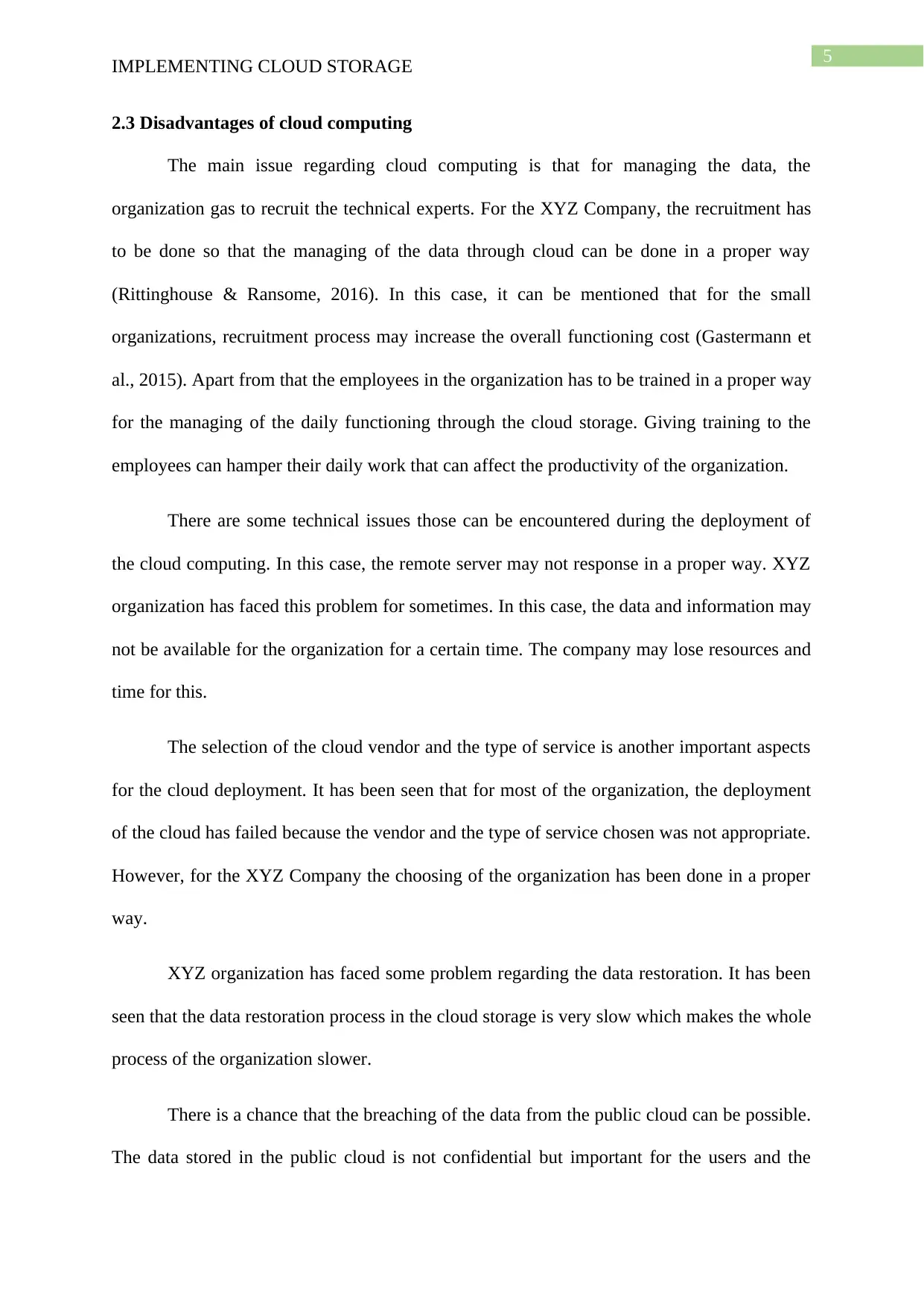
5
IMPLEMENTING CLOUD STORAGE
2.3 Disadvantages of cloud computing
The main issue regarding cloud computing is that for managing the data, the
organization gas to recruit the technical experts. For the XYZ Company, the recruitment has
to be done so that the managing of the data through cloud can be done in a proper way
(Rittinghouse & Ransome, 2016). In this case, it can be mentioned that for the small
organizations, recruitment process may increase the overall functioning cost (Gastermann et
al., 2015). Apart from that the employees in the organization has to be trained in a proper way
for the managing of the daily functioning through the cloud storage. Giving training to the
employees can hamper their daily work that can affect the productivity of the organization.
There are some technical issues those can be encountered during the deployment of
the cloud computing. In this case, the remote server may not response in a proper way. XYZ
organization has faced this problem for sometimes. In this case, the data and information may
not be available for the organization for a certain time. The company may lose resources and
time for this.
The selection of the cloud vendor and the type of service is another important aspects
for the cloud deployment. It has been seen that for most of the organization, the deployment
of the cloud has failed because the vendor and the type of service chosen was not appropriate.
However, for the XYZ Company the choosing of the organization has been done in a proper
way.
XYZ organization has faced some problem regarding the data restoration. It has been
seen that the data restoration process in the cloud storage is very slow which makes the whole
process of the organization slower.
There is a chance that the breaching of the data from the public cloud can be possible.
The data stored in the public cloud is not confidential but important for the users and the
IMPLEMENTING CLOUD STORAGE
2.3 Disadvantages of cloud computing
The main issue regarding cloud computing is that for managing the data, the
organization gas to recruit the technical experts. For the XYZ Company, the recruitment has
to be done so that the managing of the data through cloud can be done in a proper way
(Rittinghouse & Ransome, 2016). In this case, it can be mentioned that for the small
organizations, recruitment process may increase the overall functioning cost (Gastermann et
al., 2015). Apart from that the employees in the organization has to be trained in a proper way
for the managing of the daily functioning through the cloud storage. Giving training to the
employees can hamper their daily work that can affect the productivity of the organization.
There are some technical issues those can be encountered during the deployment of
the cloud computing. In this case, the remote server may not response in a proper way. XYZ
organization has faced this problem for sometimes. In this case, the data and information may
not be available for the organization for a certain time. The company may lose resources and
time for this.
The selection of the cloud vendor and the type of service is another important aspects
for the cloud deployment. It has been seen that for most of the organization, the deployment
of the cloud has failed because the vendor and the type of service chosen was not appropriate.
However, for the XYZ Company the choosing of the organization has been done in a proper
way.
XYZ organization has faced some problem regarding the data restoration. It has been
seen that the data restoration process in the cloud storage is very slow which makes the whole
process of the organization slower.
There is a chance that the breaching of the data from the public cloud can be possible.
The data stored in the public cloud is not confidential but important for the users and the
⊘ This is a preview!⊘
Do you want full access?
Subscribe today to unlock all pages.

Trusted by 1+ million students worldwide
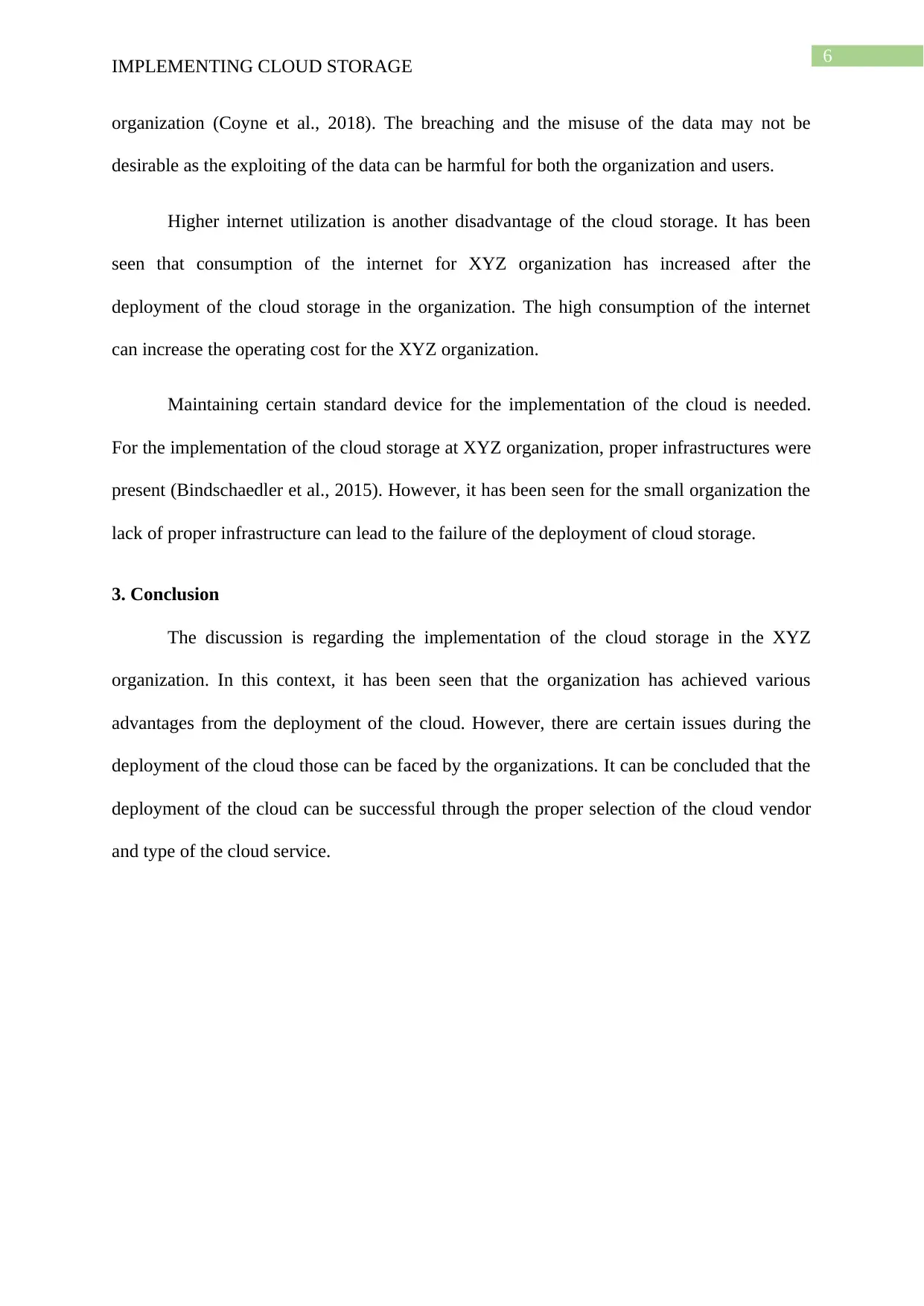
6
IMPLEMENTING CLOUD STORAGE
organization (Coyne et al., 2018). The breaching and the misuse of the data may not be
desirable as the exploiting of the data can be harmful for both the organization and users.
Higher internet utilization is another disadvantage of the cloud storage. It has been
seen that consumption of the internet for XYZ organization has increased after the
deployment of the cloud storage in the organization. The high consumption of the internet
can increase the operating cost for the XYZ organization.
Maintaining certain standard device for the implementation of the cloud is needed.
For the implementation of the cloud storage at XYZ organization, proper infrastructures were
present (Bindschaedler et al., 2015). However, it has been seen for the small organization the
lack of proper infrastructure can lead to the failure of the deployment of cloud storage.
3. Conclusion
The discussion is regarding the implementation of the cloud storage in the XYZ
organization. In this context, it has been seen that the organization has achieved various
advantages from the deployment of the cloud. However, there are certain issues during the
deployment of the cloud those can be faced by the organizations. It can be concluded that the
deployment of the cloud can be successful through the proper selection of the cloud vendor
and type of the cloud service.
IMPLEMENTING CLOUD STORAGE
organization (Coyne et al., 2018). The breaching and the misuse of the data may not be
desirable as the exploiting of the data can be harmful for both the organization and users.
Higher internet utilization is another disadvantage of the cloud storage. It has been
seen that consumption of the internet for XYZ organization has increased after the
deployment of the cloud storage in the organization. The high consumption of the internet
can increase the operating cost for the XYZ organization.
Maintaining certain standard device for the implementation of the cloud is needed.
For the implementation of the cloud storage at XYZ organization, proper infrastructures were
present (Bindschaedler et al., 2015). However, it has been seen for the small organization the
lack of proper infrastructure can lead to the failure of the deployment of cloud storage.
3. Conclusion
The discussion is regarding the implementation of the cloud storage in the XYZ
organization. In this context, it has been seen that the organization has achieved various
advantages from the deployment of the cloud. However, there are certain issues during the
deployment of the cloud those can be faced by the organizations. It can be concluded that the
deployment of the cloud can be successful through the proper selection of the cloud vendor
and type of the cloud service.
Paraphrase This Document
Need a fresh take? Get an instant paraphrase of this document with our AI Paraphraser
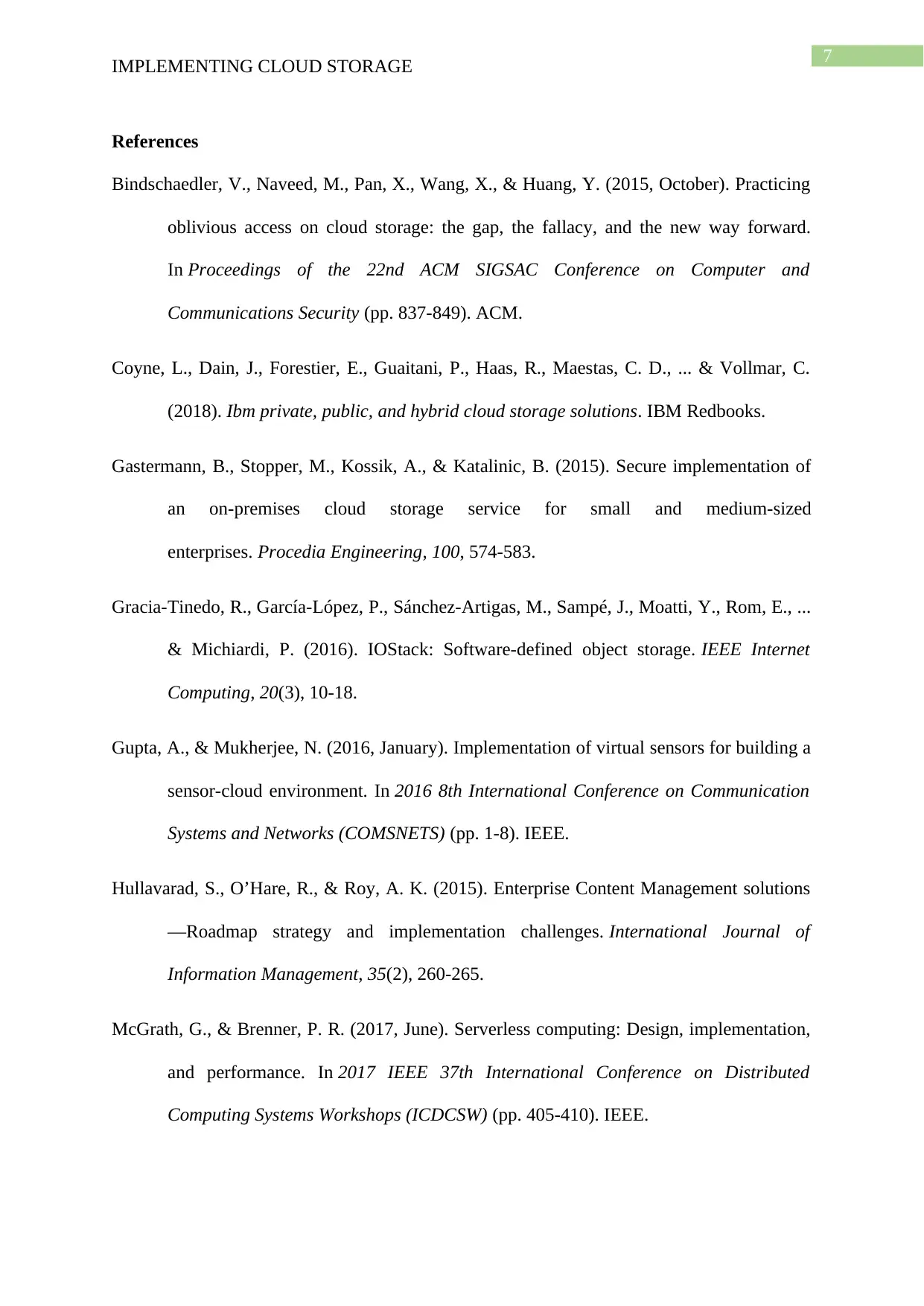
7
IMPLEMENTING CLOUD STORAGE
References
Bindschaedler, V., Naveed, M., Pan, X., Wang, X., & Huang, Y. (2015, October). Practicing
oblivious access on cloud storage: the gap, the fallacy, and the new way forward.
In Proceedings of the 22nd ACM SIGSAC Conference on Computer and
Communications Security (pp. 837-849). ACM.
Coyne, L., Dain, J., Forestier, E., Guaitani, P., Haas, R., Maestas, C. D., ... & Vollmar, C.
(2018). Ibm private, public, and hybrid cloud storage solutions. IBM Redbooks.
Gastermann, B., Stopper, M., Kossik, A., & Katalinic, B. (2015). Secure implementation of
an on-premises cloud storage service for small and medium-sized
enterprises. Procedia Engineering, 100, 574-583.
Gracia-Tinedo, R., García-López, P., Sánchez-Artigas, M., Sampé, J., Moatti, Y., Rom, E., ...
& Michiardi, P. (2016). IOStack: Software-defined object storage. IEEE Internet
Computing, 20(3), 10-18.
Gupta, A., & Mukherjee, N. (2016, January). Implementation of virtual sensors for building a
sensor-cloud environment. In 2016 8th International Conference on Communication
Systems and Networks (COMSNETS) (pp. 1-8). IEEE.
Hullavarad, S., O’Hare, R., & Roy, A. K. (2015). Enterprise Content Management solutions
—Roadmap strategy and implementation challenges. International Journal of
Information Management, 35(2), 260-265.
McGrath, G., & Brenner, P. R. (2017, June). Serverless computing: Design, implementation,
and performance. In 2017 IEEE 37th International Conference on Distributed
Computing Systems Workshops (ICDCSW) (pp. 405-410). IEEE.
IMPLEMENTING CLOUD STORAGE
References
Bindschaedler, V., Naveed, M., Pan, X., Wang, X., & Huang, Y. (2015, October). Practicing
oblivious access on cloud storage: the gap, the fallacy, and the new way forward.
In Proceedings of the 22nd ACM SIGSAC Conference on Computer and
Communications Security (pp. 837-849). ACM.
Coyne, L., Dain, J., Forestier, E., Guaitani, P., Haas, R., Maestas, C. D., ... & Vollmar, C.
(2018). Ibm private, public, and hybrid cloud storage solutions. IBM Redbooks.
Gastermann, B., Stopper, M., Kossik, A., & Katalinic, B. (2015). Secure implementation of
an on-premises cloud storage service for small and medium-sized
enterprises. Procedia Engineering, 100, 574-583.
Gracia-Tinedo, R., García-López, P., Sánchez-Artigas, M., Sampé, J., Moatti, Y., Rom, E., ...
& Michiardi, P. (2016). IOStack: Software-defined object storage. IEEE Internet
Computing, 20(3), 10-18.
Gupta, A., & Mukherjee, N. (2016, January). Implementation of virtual sensors for building a
sensor-cloud environment. In 2016 8th International Conference on Communication
Systems and Networks (COMSNETS) (pp. 1-8). IEEE.
Hullavarad, S., O’Hare, R., & Roy, A. K. (2015). Enterprise Content Management solutions
—Roadmap strategy and implementation challenges. International Journal of
Information Management, 35(2), 260-265.
McGrath, G., & Brenner, P. R. (2017, June). Serverless computing: Design, implementation,
and performance. In 2017 IEEE 37th International Conference on Distributed
Computing Systems Workshops (ICDCSW) (pp. 405-410). IEEE.
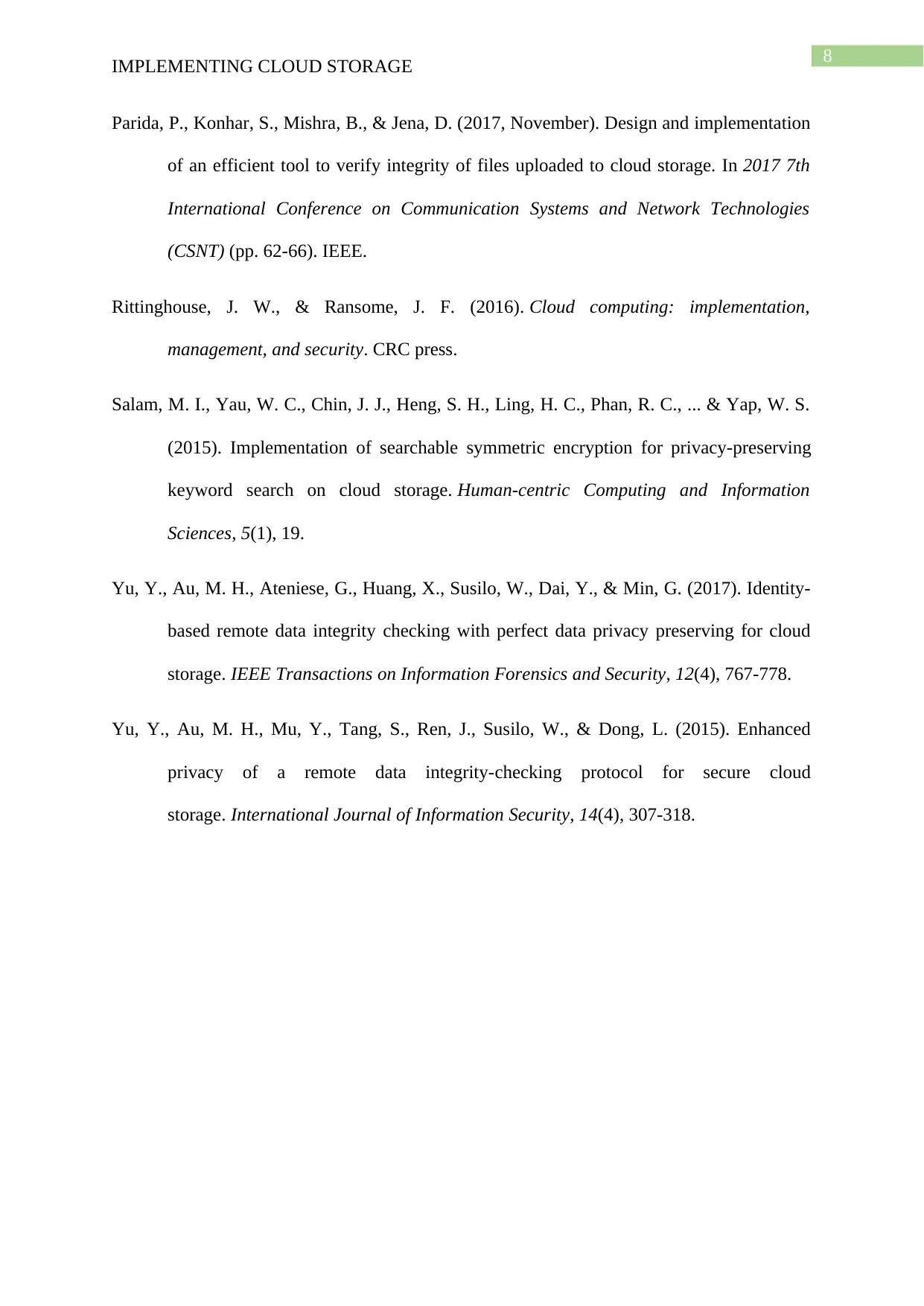
8
IMPLEMENTING CLOUD STORAGE
Parida, P., Konhar, S., Mishra, B., & Jena, D. (2017, November). Design and implementation
of an efficient tool to verify integrity of files uploaded to cloud storage. In 2017 7th
International Conference on Communication Systems and Network Technologies
(CSNT) (pp. 62-66). IEEE.
Rittinghouse, J. W., & Ransome, J. F. (2016). Cloud computing: implementation,
management, and security. CRC press.
Salam, M. I., Yau, W. C., Chin, J. J., Heng, S. H., Ling, H. C., Phan, R. C., ... & Yap, W. S.
(2015). Implementation of searchable symmetric encryption for privacy-preserving
keyword search on cloud storage. Human-centric Computing and Information
Sciences, 5(1), 19.
Yu, Y., Au, M. H., Ateniese, G., Huang, X., Susilo, W., Dai, Y., & Min, G. (2017). Identity-
based remote data integrity checking with perfect data privacy preserving for cloud
storage. IEEE Transactions on Information Forensics and Security, 12(4), 767-778.
Yu, Y., Au, M. H., Mu, Y., Tang, S., Ren, J., Susilo, W., & Dong, L. (2015). Enhanced
privacy of a remote data integrity-checking protocol for secure cloud
storage. International Journal of Information Security, 14(4), 307-318.
IMPLEMENTING CLOUD STORAGE
Parida, P., Konhar, S., Mishra, B., & Jena, D. (2017, November). Design and implementation
of an efficient tool to verify integrity of files uploaded to cloud storage. In 2017 7th
International Conference on Communication Systems and Network Technologies
(CSNT) (pp. 62-66). IEEE.
Rittinghouse, J. W., & Ransome, J. F. (2016). Cloud computing: implementation,
management, and security. CRC press.
Salam, M. I., Yau, W. C., Chin, J. J., Heng, S. H., Ling, H. C., Phan, R. C., ... & Yap, W. S.
(2015). Implementation of searchable symmetric encryption for privacy-preserving
keyword search on cloud storage. Human-centric Computing and Information
Sciences, 5(1), 19.
Yu, Y., Au, M. H., Ateniese, G., Huang, X., Susilo, W., Dai, Y., & Min, G. (2017). Identity-
based remote data integrity checking with perfect data privacy preserving for cloud
storage. IEEE Transactions on Information Forensics and Security, 12(4), 767-778.
Yu, Y., Au, M. H., Mu, Y., Tang, S., Ren, J., Susilo, W., & Dong, L. (2015). Enhanced
privacy of a remote data integrity-checking protocol for secure cloud
storage. International Journal of Information Security, 14(4), 307-318.
⊘ This is a preview!⊘
Do you want full access?
Subscribe today to unlock all pages.

Trusted by 1+ million students worldwide

9
IMPLEMENTING CLOUD STORAGE
IMPLEMENTING CLOUD STORAGE
1 out of 10
Related Documents
Your All-in-One AI-Powered Toolkit for Academic Success.
+13062052269
info@desklib.com
Available 24*7 on WhatsApp / Email
![[object Object]](/_next/static/media/star-bottom.7253800d.svg)
Unlock your academic potential
Copyright © 2020–2025 A2Z Services. All Rights Reserved. Developed and managed by ZUCOL.



